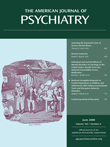To The Editor: Charcot-Marie-Tooth disease is a severe neurological disorder affecting both motor and sensory peripheral nerves. In patients with peripheral autonomic nervous or respiratory system involvement, anesthesia management can be difficult. A higher risk for malignant hyperthermia and succinylcholine-induced hyperkalemia during anesthesia in patients with Charcot-Marie-Tooth disease is under discussion
(1,
2) . These issues may limit the possibility for psychiatric patients with Charcot-Marie-Tooth disease to undergo electroconvulsive therapy (ECT). We present the first case of a successful performance of ECT in a patient suffering from both severe treatment-resistant depression and Charcot-Marie-Tooth disease.
“Mr. T,” a 70-year-old man suffering from Charcot-Marie-Tooth disease type I, with pronounced muscle atrophy in the upper and lower extremities, was referred to our department with severe, delusional, first-episode depression. For almost 2 years, a loss of drive, delusions of poverty, and near mutism were the most prominent symptoms. Since the patient had previously been resistant to any antidepressant (citalopram, clomipramine, duloxetine, mirtazapine, paroxetine, reboxetine, tranylcypromine) or antipsychotic (haloperidol, olanzapine, quetiapine, risperidone), we decided to perform ECT.
Electroencephalography and magnetic resonance imaging did not reveal any pathology. Blood gas analysis showed a slight compensated respiratory acidosis (PaO 2 =83 mmHg, PaCO 2 =44 mmHg, pH=7.41, HCO 3 =27 mmol/l, BE= –0.9 mmol/l). Both body plethysmographic and spirometric measurements were normal, with regular vital capacity (4.27 l, 102% predicted) and Tiffeneau index (85%, 114% predicted).
The patient received eight unilateral and seven bitemporal electroconvulsive treatments (bidirectional: 309 to 622 mC; length of stimulus train: 5.2 to 8 seconds) over a period of 6 weeks. Concomitant antidepressant and antipsychotic medications (reboxetine, 4 mg; risperidone 2 mg per day) were continued during ECT. Anesthesia was induced with intravenous propofol (2.5 mg/kg) and mivacurium (0.1 mg/kg), followed by oxygenation, with 100% oxygen for 4 minutes. Severity of depression was assessed using the 21-item Hamilton Depression Rating Scale (HAM-D) every 14 days during ECT treatment.
Except for several short episodes of bradycardia (minimum 42 bpm) during anesthesia and a delayed recovery phase after ECT (approximately 10 minutes), no significant complications occurred during anesthesia and ECT, nor were there any cognitive disturbances. Within a few sessions, the patient showed improved mood and a clear increase in drive and social activity. His HAM-D score decreased from 36 at baseline to 22 by the end of ECT treatment. This effect has been sustained with lithium and bupropion following ECT for more than 6 months.
To our knowledge, this is the first report of ECT in a patient suffering from concomitant Charcot-Marie-Tooth disease. Thus, with adequate prearrangement, ECT can safely be performed in patients suffering from both Charcot-Marie-Tooth disease and pharmacotherapy-resistant psychiatric disorders. Nevertheless, ECT anesthesia procedures should be standardized based on systematic evaluations.

